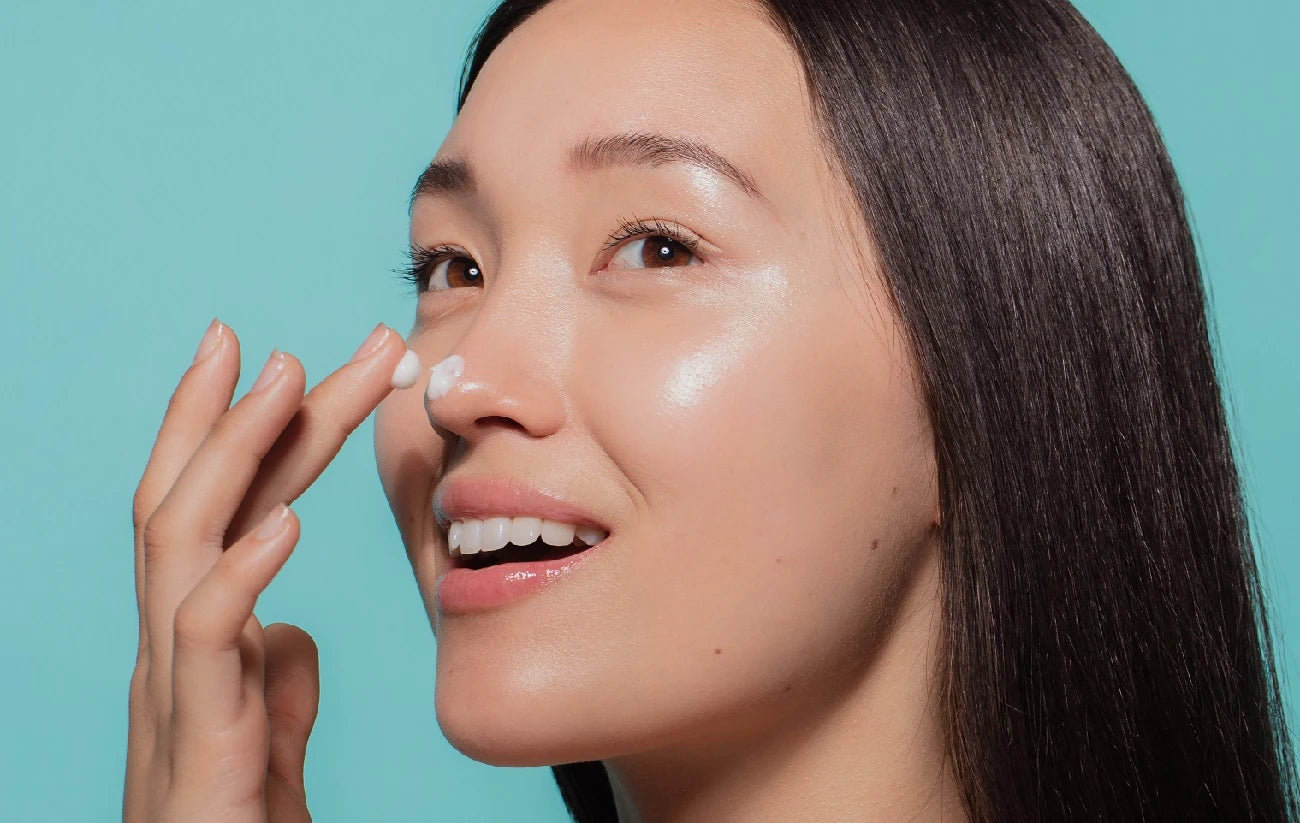[adinserter block=”5″]
Layering skin care products with dimethicone – or any combination of ingredients – is important to the results you get from your skin care routine. Your carefully considered individual skin care products are made from ingredients that may not combine well, may prevent absorption of other products or may create unwanted feel or film on your skin. A reader asked me the very important question about product layering in the context of dimethicone and I’m going to share my answer with you. The concepts apply to all product layering, whether there is dimethicone in your product or not.
Hello Dr. Bailey, layering skin care products with dimethicone is something I am wondering about. My moisturizer contains dimethicone and I am just wondering if that would prevent the tretinoin (Retin A) that I use from penetrating my skin? Should I apply tretinoin first then my moisturizer? Does it really matter if I apply it before or after the tretinoin? Thank you very much for your time. Sincerely, Rui
Dear Rui,
This is an excellent question. The skin care products that you apply, and their ingredients, do affect each other in a number of ways. Absorption is one of them. We layer products because some ingredients can’t be placed together in the same bottle, tube or jar and stored for months to years but are compatible and active when layered on your skin for 12 hours.
The layering order of skin care products is important to product results, but it’s also difficult to be absolutely certain that we know what’s actually going on at the skin level. That’s because it’s not possible to study all the product or ingredient combinations. At some point, we have to think things through with general scientific principles as best we can.
Layering Skin Care Products
As a general rule I recommend thinner and/or water-based skin care products first and thicker/oil-based or dimethicone containing products after.
You have heard that “water and oil don’t mix”. It is a helpful concept regarding products. Your skin is more complex because it’s composed of lipids (oils which we say are lipophilic) and protein (that ‘likes’ water and we describe as hydrophilic). This means that the lipids will absorb ingredients that mix well with oil and the protein will absorb ingredients that mix well with water. We use this to our advantage in product layering.
Layering ‘occlusive’ skin care products
When layering your skin care products, there is the additional concept that is important and that is that some ingredients are ‘occlusive’. I like to say that they “seal the deal” with products layered before and help prevent skin dryness. It does not mean that an ingredient makes your skin feel heavy or that the ingredient clogs pores, it just means that it will layer on top of the skin to prevent water loss. This applies to oils and dimethicone.
Occlusive ingredients such as oils and dimethicone (a siloxane that includes other ingredients in this family such as cyclopentasiloxane and cyclohexasiloxane) will help prevent water evaporation from skin called Transepidermal Water Loss (TEWL). On the other hand, water-based formulations will penetrate skin and also evaporate if they are not ‘trapped’. We use occlusion to help trap water-based ingredients as well as water that keeps your skin hydrated and supple.
Lastly, there are individual ingredient combinations need to be considered one at a time. I’m going to start with dimethicone, which has its fans. That said, some people prefer to use more ‘natural’ occlusive such as botanical oils.
Is dimethicone bad for skin?
My opinion is that dimethicone can be a great skin care ingredient when formulated into a product carefully. I also like natural oils in skin care. The bottom line is that dimethicone has some excellent reasons for being in your skin care products.
4 benefits of dimethicone in skin care
- Dimethicone is added to skin care products because it helps them to glide nicely over your skin.
- A little dimethicone on your skin also gives it a wonderful silky feel and softens the appearance of fine wrinkles.
- It improves your skin’s ability to retain moisture and helps to protect it from irritation.
- It is moisturizing, skin softening, noncomedogenic and nonacnegenic and prevents excess oil from diluting other skin care products such as makeup.
- Dimethicone may even slightly improve the thickness of the top living layer of your skin called the epidermis.

Because it acts as a barrier however, dimethicone may affect the penetration of some ingredients such as Retin A into the skin. It depends on how much dimethicone is in the product though. Products with a large amount of dimethicone could well block tretinoin if they are applied first.
Products with a relatively small amount of dimethicone such as my Daily Moisturizing Face Cream work well with tretinoin. I have built thousands of tretinoin and retinol skin care routines with this cream and have never found it to have any negative impact on Retin A penetration in terms of the obvious visible results of tretinoin.
How do you know if tretinoin Retin A can penetrate your dimethicone moisturizer?
If you have any doubts about your products, you can always test them because Retin A will irritate your skin every now and then if it’s penetrating. When I help my patients figure out this product combination, I tell them that if they’re on the strongest level of Retin A cream and they never get irritated then either they have really tough skin or something they are doing before application of the Retin A may be affecting its penetration.
Likewise, tretinoin will reduce blackheads to treat acne and cause skin brightening, improvement in uneven pigment and reduction in fine lines and wrinkles. All of these results are 100% visible to you in the mirror. If you see tretinoin working, it’s getting through and being absorbed into your skin!
How to layer skin care at night with Retin A
For example, I personally have use my Daily Moisturizing Face Cream for years with its dimethicone content. The layering order of my nighttime products with tretinoin is:
- Green Tea Antioxidant Skin Therapy Cream,
- Daily Moisturizing Face Cream,
- wait 15 minutes or more, then
- I apply my tretinoin (Retin A).
Notice that I recommend applying the Green Tea Therapy Cream first because it is a thinner product. It is not water based but the consistency is much less occlusive.
I can and do get very chapped from Retin A from time to time and so I know that the Retin A is getting through the Daily Moisturizing Face Cream. I can also see the beneficial results in the mirror.
Apply moisturizer before tretinoin not after tretinoin
There is no point in applying your moisturizer after Retin A because moisturizers need to be applied immediately after toweling your skin dry in order for them to work. Retin A in my practice, on the other hand, is always applied after waiting 15 or more minutes after toweling dry and applying other products (including your moisturizer). This helps to prevent skin irritation, chapping and the retinoid dermatitis. I’ve been prescribing tretinoin since it was first released for acne in the mid-1980s. I have extensive experience with helping all complexion types tolerate this medicine and I’ve learned that waiting 15 minutes really reduces tretinoin skin peeling.
Preventing skin irritation is why I apply my moisturizer, wait 15 minutes or more and then apply my Retin A last. – Dr. Bailey
Retinol causes less skin irritating than tretinoin for sensitive complexions
Some people with sensitive skin don’t want the inconvenience of tretinoin or want to alternate it with an easier to use retinoid. Retinol is known to be less likely to lead to retinoid dermatitis. It has the same mechanism of action as tretinoin though needs to be used in higher concentrations to stimulate collagen renewal.
Retinol can be applied right after washing and toweling skin dry. My Retinol Anti-Wrinkle Night Cream comes contains the highest allowed retinol concentration, which is 1%, which we denote as 10X. This is a medical-grade retinol that you would expect from a dermatologist and retinoid expert.
My Retinol Night Cream is also formulated with the same green tea antioxidants as my Green Tea Cream and it has dimethicone. I actually like it topped with my Daily Moisturizing Cream for the added benefit of ceramides and squalane in the Daily Cream. Frankly, I do this 3 to 4 nights a week and the tretinoin routine all of the others.
My face always sleeps with a retinoid because they are the best ingredients to fight the signs of skin aging and I want that! – Dr. Bailey
Retinol Anti-Wrinkle Night Cream contains dimethicone
Get the benefits of three beneficial ingredients in one product.
I alternate my Retinol Cream with tretinoin (or use it more often than tretinoin since it is easier) and apply it right after cleansing my face, neck and chest at night.
How long do you wait to apply moisturizer after retinol?
Let the retinol product dry to the touch but beyond that, there is no need to wait. I apply retinol and then I layer my Daily Face Cream on top. If the retinol is not entirely dry to the touch, it’s possible to pat the moisturizer onto skin.
Can you use a face oil with retinol?
Yes. As of this update in 2023 my post menopausal 64 year old complexion needs even more lipid ingredients. I top my retinol with the Daily Moisturizing Face Cream boosted with a few drops of my Omega Face Booster Oil which contains beautiful botanical barrier healing oils. Sometimes I even apply my face oil straight without cream and directly on top of the Retinol Night Cream. It’s easy to tell that that the retinol is working because the skin brightening is visible in the mirror. That’s 37+ years of using a nightly retinoid cream and my skin looks younger than my joints feel!
This was a great question that shows you understand quite a lot about skin care ingredients. I hope my answer helped.
Warm Regards,
Cynthia Bailey MD, Dermatologist
Click here to see my Retinol Anti-Wrinkle Night Cream and Daily Moisturizing Face Cream
Disclaimer: Please realize that availing yourself of the opportunity to submit and receive answers to your questions from Dr. Bailey does not confer a doctor/patient relationship with Dr. Bailey. The information provided by Dr. Bailey is general health information inspired by your question. It should not be a substitute for obtaining medical advice from your physician and is not intended to diagnose or treat any specific medical problem (and is not an extension of the care Dr. Bailey has provided in her office for existing patients of her practice). Never ignore your own doctor’s advice because of something you read here; this information is for general informational purpose only.
[adinserter block=”5″]
Source link




